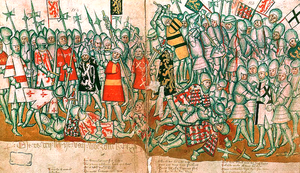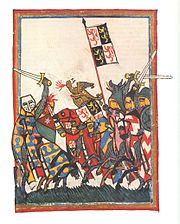| Battle of Worringen | |||||||||
|---|---|---|---|---|---|---|---|---|---|
| Part of the War of the Limburg Succession | |||||||||
 Illustration from the medieval chronicle Brabantsche Yeesten | |||||||||
| |||||||||
| Belligerents | |||||||||
|
|
| ||||||||
| Commanders and leaders | |||||||||
|
Archbishop of Cologne | John I, Duke of Brabant | ||||||||
| Strength | |||||||||
| 4,200 | 4,800 | ||||||||
| Casualties and losses | |||||||||
| ca 1,100a | ca 40 | ||||||||
| a: A substantial proportion of the male members of the House of Luxembourg lost their lives as a result of this battle. | |||||||||
The Battle of Worringen was fought on June 5, 1288, near the town of Worringen (also spelled Woeringen), which is now the northernmost borough of Cologne. The battle was fought for the possession of the Duchy of Limburg, and was one of the largest battles in Europe in the Middle Ages.
Prelude[]

John I, Duke of Brabant, at the Battle of Worringen, Codex Manesse, about 1340
The conflict arose after the last Waleran IV, Duke of Limburg, had died without male heirs in 1279, and his duchy was inherited by his daughter Ermengarde, who had married Reginald I, Count of Guelders. When she died childless one year later, her husband claimed the Duchy of Limburg and in 1282 had his demand recognized by the German king Rudolph of Habsburg.
However, Waleran's nephew Adolf VIII, Count of Berg, son of his elder brother Adolf VII, also claimed the duchy after Ermengarde's death. Unable to assert his claims, he sold them in 1283 to the mighty John I, Duke of Brabant. Duke John intended to enlarge his territory and reunite the former Duchy of Lower Lorraine, while Limburg was also economically important as it stretched along the major trade route to the Rhine. Though Brabant held the title of a Duke of Lothier since 1190, it had been solely honorific and did not imply any inheritance claims. The Limburg nobles therefore refused to accept John's overlordship.
Between 1283 and 1288, the conflict was delayed by several smaller confrontations between both sides, none of them decisive. Meanwhile, most of the other local powers chose sides. Foremost Siegfried II of Westerburg, the Archishop of Cologne, suspiciously eyed John's gain in power. In view of their common interests he and Reginald I forged an alliance, joined by Henry VI, Count of Luxembourg, and his brother Waleran I, Lord of Ligny, as well as by Adolf, Count of Nassau. On the other side the Counts of Mark took the chance to affirm their independence from the Archbishop of Cologne and together with the Counts of Loon, Tecklenburg and Waldeck allied with Brabant and Berg.
The battle[]
In May 1288, Henry of Luxembourg had led a significant army into the Cologne region and Reinoud of Guelders finally sold his rights to Limburg to him, just before peace talks were scheduled. This angered John of Brabant, who started a campaign against Reinoud. By the end of the month, both sides met at Worringen, a castle on the Rhine held by the Archbishop of Cologne. John laid siege to the fortress, supported by the Cologne citizens, who were eager to emancipate themselves from the Archbishop's rule.
On the morning of June 5, Archbishop Siegfried marched toward Worringen at the head of his troops. In the earliest phases of the battle, John of Brabant and Henry VI, Count of Luxembourg, met in a fierce fight, in which Henry and two of his brothers [1] was killed.[2] Soon after that, Siegfried entered the battle and was able to beat off the Berg troops and the Cologne militia, however with too little support from his back army. He was taken prisoner by John of Brabant and delivered to Adolf of Berg. The battle ended in a victory for Brabant when Reinoud of Guelders was captured by Daniel van Bouchout[3][4] and Lord Walram of Valkenburg had to retreat.
Aftermath[]

Detail from memorial at Düsseldorf, bronze, 1988
The number of deaths at the battle of Worringen is estimated at 1100 on the Guelders side and 40 on the Brabant side. The blood toll on the house of Luxembourg was particularly high: most of the male relatives of the later German emperor Henry VII perished there. Archbishop Siegfried was imprisoned for over a year at Schloss Burg, before he paid a ransom and agreed to Count Adolf's demands. Worringen Castle and several other fortresses of the bishop were demolished. On 14 August 1288, Adolf granted Düsseldorf city rights, whereafter it became the capital of Berg. Reinoud of Guelders was released after he had renounced all claims to the Duchy of Limburg.
The Battle of Worringen meant a rise in the power of Brabant, Berg and Mark, while the City of Cologne gained its independence from the Archbishopric and finally the status of an Imperial city in 1475. The Duchy of Limburg was added to the Duchy of Brabant in 1289, an arrangement approved by King Rudolph and again by his former opponent Adolf of Nassau, after he was elected King of the Romans in 1292. In Luxembourg, Henry VI was followed by his nine-year-old son Henry VII, who in 1292 settled the conflict with Brabant by marrying John's daughter Margaret. The Archbishopric of Cologne never recovered from the loss of the city of Cologne.
Jan van Heelu wrote a chronicle of the battle.[5]
References[]
| Wikimedia Commons has media related to Battle of Worringen. |
Notes[]
- ↑ Walram of Ligny and Henry of Houffalize (bastard)
- ↑ Noppen 1991, pp. 46–48.
- ↑ Van Heelu & Willems 1836, p. 310.
- ↑ Loyens 1672, p. 10.
- ↑ Van Heelu & Willems 1836.
Bibliography[]
- Boffa, S. 2004. Warfare in medieval Brabant: 1356-1406. Coll.: "Warfare in History", Boydell Press, Woodbridge, UK, 289 p.
- Loyens, Hubert (1672). "Synopsis AB Serenissimis, Ducibus. Johannes I, Dux Lotharingae, Brabantiae, Limburgi". Brussels. http://books.google.nl/books?id=H15AAAAAcAAJ&printsec=frontcover.
- Noppen, Constant (1991). "De heren van Boechout en hun Waterburcht te Meise". Brussel: Drukkerij Poot.
- Van Heelu, Jan; Willems, Jan Frans (1836). "Relation de la bataille de Woeringen". Brussels. http://books.google.nl/books?id=95oBAAAAYAAJ&printsec=frontcover.
Wargames[]
- Frédéric Bey, Swords of Sovereignty: Bouvines 1214 and Worringen 1288, Au fil de l'épée series, Ludifolie Editions (2012)
Coordinates: 51°02′33″N 6°53′16″E / 51.0425°N 6.88778°E
The original article can be found at Battle of Worringen and the edit history here.